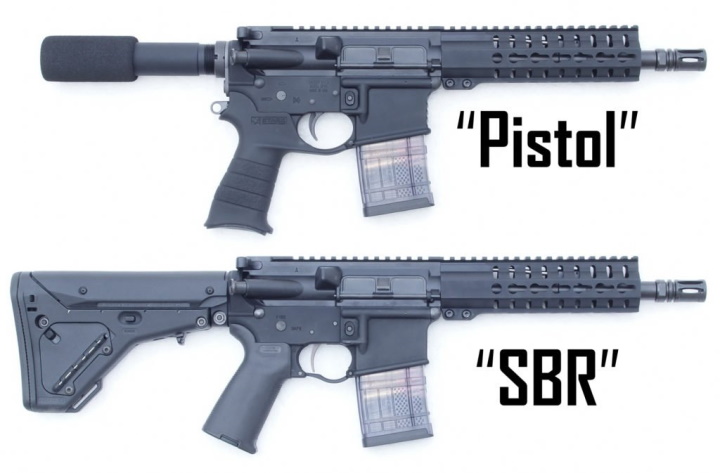Should You Build An AR Pistol Or SBR
From Primary Arms
When you’re deciding on what kind of short AR you want to build (for which you’d need to start with a high-quality upper receiver), one of the biggest, and most confusing decisions you’ll have to make is whether you want to make it as a Short Barreled Rifle (SBR) or as a pistol.
The Difference Between an AR15 Pistol and SBR
Here, we’re going to carefully define what an SBR and a pistol mean in the context of building an AR, as well as some of the advantages and disadvantages of each. From there, we make our recommendations which, of course, should not be construed as legal advice to you.
The ATF defines a short-barreled rifle as one that has a barrel less than sixteen inches in length, having a buttstock, and was made as a rifle. For ARs, that means that you start the build with a rifle receiver, not one that was made as a pistol, even though they are, mechanically, identical. The thing that matters is how the original manufacturer reported the gun to the ATF when it was made. To own one, you first must register it with the ATF and pay a $200 fee.
A pistol, on the other hand, is an AR with any barrel length that was sold as a pistol. It cannot have a vertical foregrip nor can it have a buttstock. These are sold as either complete pistols from the factory, or you can make one with a pistol receiver. Rather than a buttstock, you’ll usually see either a bare buffer tube or a pistol brace.
The Benefits of an AR-15 SBR
Despite having to pay an NFA tax for it, there are some benefits to owning an SBR. First and foremost, you can put any accessories you like on it with no issues, such as a vertical grip and a stock. This is the main reason a lot of people go the SBR route, especially if they plan, for example, to run it with a suppressor and thus already must fill out government paperwork and pay extra taxes.
One major downside to an SBR is that you must get permission from individual states to bring them in. So, for example, if you want to use your AR as a truck gun, you must notify and get permission from each state before entering it. This, for some people, is a deal-breaker. Also, if you ever go to sell your SBR, the new owner must fill out the same paperwork and pay the same taxes you did before the transfer can happen.
The Benefits of an AR-15 Pistol
Pistols can be taken from state to state with no issue, assuming the pistol is legal to own in all the places involved. The downside here is the regulation on accessories such as stocks and forward grips. Most people run a brace and a slanted foregrip and are, generally, okay with that.
Although I like the idea of being able to put any accessories I please on my short AR, I would go with a pistol over an SBR, and I’d do that for three main reasons. First and foremost, the idea of paying an extra tax and filing paperwork with the government makes an SBR an unattractive option to me. Second, I move often enough that registering the gun with each new state would be a pain, as would be selling it if I moved to a place where ARs aren’t legal. Finally, since the ATF is okay with us shouldering pistol braces, you can get most of the utility of an SBR without any of the paperwork or hassle of an SBR.
Conclusion
Assuming you go with a pistol AR, then I would highly recommend simply going with a hand stop, a pistol brace, and a sling. That way, the overall firearm stays nice and light. It doesn’t make a great deal of sense to me to overload a short AR with too many accessories that make the gun just as heavy as a full-length M4 style of AR.
While it’s certainly possible to build either an SBR or a pistol, the extra paperwork and cost of an SBR might make a pistol the better option for you. That said, a lot of folks do go through the time and expense for an SBR and are extremely happy with the results.
*This article was submitted by Primary Arms for distribution by RTT: Guns & Gear


